The simplest solution is to omit the cv2.cvtColor(), which will cause the image channels to swap, effectively making blue look like orange. Here is an example (for mediapipe==0.9.0):
import cv2
import mediapipe as mp
mp_drawing = mp.solutions.drawing_utils
mp_drawing_styles = mp.solutions.drawing_styles
mp_hands = mp.solutions.hands
with mp_hands.Hands(
static_image_mode=True,
max_num_hands=2,
min_detection_confidence=0.5) as hands:
image = cv2.imread("gloves.jpg")
results = hands.process(image)
if results.multi_hand_landmarks:
image_height, image_width, _ = image.shape
for hand_landmarks in results.multi_hand_landmarks:
mp_drawing.draw_landmarks(
image,
hand_landmarks,
mp_hands.HAND_CONNECTIONS,
mp_drawing_styles.get_default_hand_landmarks_style(),
mp_drawing_styles.get_default_hand_connections_style())
else:
print("no hands were found")
cv2.imshow("result", image)
cv2.waitKey(0)
This should be sufficient for MediaPipe to recognize the hands:

Alternatively, you can also make a fine-tuning of the color change using Hue offset in HSV schema (adapted from here). This would be a "better" solution since it only changes the hue but does not swap the channels.
Edit: I've created a simple Hue-tunning "GUI-like" script that helps to find suitable Hue-offset:
import cv2
import mediapipe as mp
mp_drawing = mp.solutions.drawing_utils
mp_drawing_styles = mp.solutions.drawing_styles
mp_hands = mp.solutions.hands
window_title = 'Recognition result'
trackbar_title = 'Hue offset'
class HueHelper:
def __init__(self):
self.mp_hands = mp_hands.Hands(static_image_mode=True,
max_num_hands=2,
min_detection_confidence=0.5)
self.img_bgr = None
def apply_hue_offset(self,image, hue_offset):# 0 is no change; 0<=huechange<=180
# convert img to hsv
img_hsv = cv2.cvtColor(image, cv2.COLOR_BGR2HSV)
h = img_hsv[:,:,0]
s = img_hsv[:,:,1]
v = img_hsv[:,:,2]
# shift the hue
# cv2 will clip automatically to avoid color wrap-around
img_hsv = cv2.add(h, hue_offset)
# combine new hue with s and v
img_hsv = cv2.merge([img_hsv,s,v])
# convert from HSV to BGR
return cv2.cvtColor(img_hsv, cv2.COLOR_HSV2BGR)
def on_trackbar_change(self, trackbar_hue_offset):
img_bgr_modified = self.recognize(self.img_bgr.copy(), trackbar_hue_offset)
cv2.imshow(window_title, img_bgr_modified)
def recognize(self, img_bgr, hue_offset):
img_bgr = self.apply_hue_offset(img_bgr, hue_offset)
img_rgb = cv2.cvtColor(img_bgr, cv2.COLOR_BGR2RGB)
results = self.mp_hands.process(img_rgb)
if results.multi_hand_landmarks:
for hand_landmarks in results.multi_hand_landmarks:
mp_drawing.draw_landmarks(
img_bgr,
hand_landmarks,
mp_hands.HAND_CONNECTIONS,
mp_drawing_styles.get_default_hand_landmarks_style(),
mp_drawing_styles.get_default_hand_connections_style())
else:
print('no hands were found')
return img_bgr
def run(self, img_path):
self.img_bgr = cv2.imread(img_path)
if self.img_bgr is None: print('Image was not found!')
self.on_trackbar_change(0)
# Hue range is 0-179: https://docs.opencv.org/4.x/df/d9d/tutorial_py_colorspaces.html
cv2.createTrackbar(trackbar_title, window_title, 0, 179, self.on_trackbar_change)
cv2.waitKey(0)
cv2.destroyAllWindows()
if __name__ == '__main__':
h = HueHelper()
h.run('gloves.jpg')
Again, a demo:


